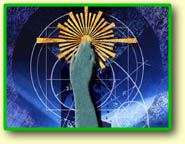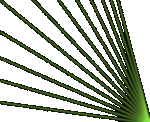|
Representational features of holograms
After the time of
nascency of the artistic holography, after the euphoria's period, caused by development of
new opportunities, it is necessary to think about a role of this technology in a line of
other representational technologies, its specific features and limitations and, at last,
opportunities of a new kind of fine art, based on this technology.
 As
holography is closest to a photography, we shall consider in more detail differences of
the holographic and photographic images: As
holography is closest to a photography, we shall consider in more detail differences of
the holographic and photographic images:
The hologram forms the
real volumetric image, unlike a photo and even such imitations of volumetric images, as
stereograms. The reality is, that the hologram can be observed from different points,
observing parts of object or scene, which were hidden from other point of view. In this
sense the holographic image behaves completely as real object. It is especially
illustrated by the holographic images of transparent objects, for example, the hologram of
a lens completely keeps all properties of a real lens, and it is possible to look through
the image of a lens the increased images of the objects, located behind it.
But, self-luminous
objects, for example, incandescent bulb can not be displayed on the hologram. It follows
from the holographic technology - object being holographed should be covered by laser
light, and only this light is recorded on the hologram.
The dynamic range of
brightness on the hologram is much more higher, than on a photo. On a photo (as by the way
in painting), maximal brightness is simply brightness of the unpainted sheet of a paper
(or brightness of a white paint). Such limitation is not present on the holographic image,
because bright places are formed by light coming from all surface of the hologram. On the
paper, image's brightness is formed by subtraction of the maximal brightness, but on the
hologram - redirection of light from dark sites to bright. Just it explains a surprising
reality of images of transparent subjects, such as glass, water drops, that is those
objects, which actually have very large dynamic range of brightness. That to the artists
and photographers is given with the large work, because of special receptions, the
hologram displays automatically and exactly.
But, unlike photos and
pictures, it is necessary a dot light source (lamp) to observe the holograms, in other
case image is slightly blurred.
Holography accurately
transfers texture of surface of the object. At anyone photographic or polygraphic
performance of the image it is impossible to exclude completely influence of texture of
the material or painting layer. Even in a qualitative offset printing there is a structure
of a surface determined by technology, besides because of presence of mirror reflection on
the image the patches of light can be formed or it can be painted by colour of the nearest
subjects. The holographic image basically has not the material canvas, as it formed in
free space. It determines amazing exact transfer of the texture of a surface of any
material.-->
|





